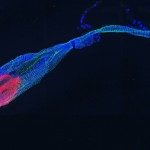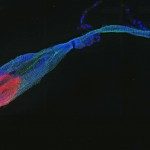Link to Pubmed [PMID] – 12372610
FEBS Lett. 2002 Oct;529(2-3):256-60
The conversion of the cellular prion protein into the beta-sheet-rich scrapie prion protein is thought to be the key step in the pathogenesis of prion diseases. To gain insight into this structural conversion, we analyzed the intrinsic structural propensity of the amino acid sequence of the murine prion C-terminal domain. For that purpose, this globular domain was dissected into its secondary structural elements and the structural propensity of the protein fragments was determined. Our results show that all these fragments, excepted that strictly encompassing helix 1, have a very high propensity to form structured aggregates with a dominant content of beta-sheet structures.

